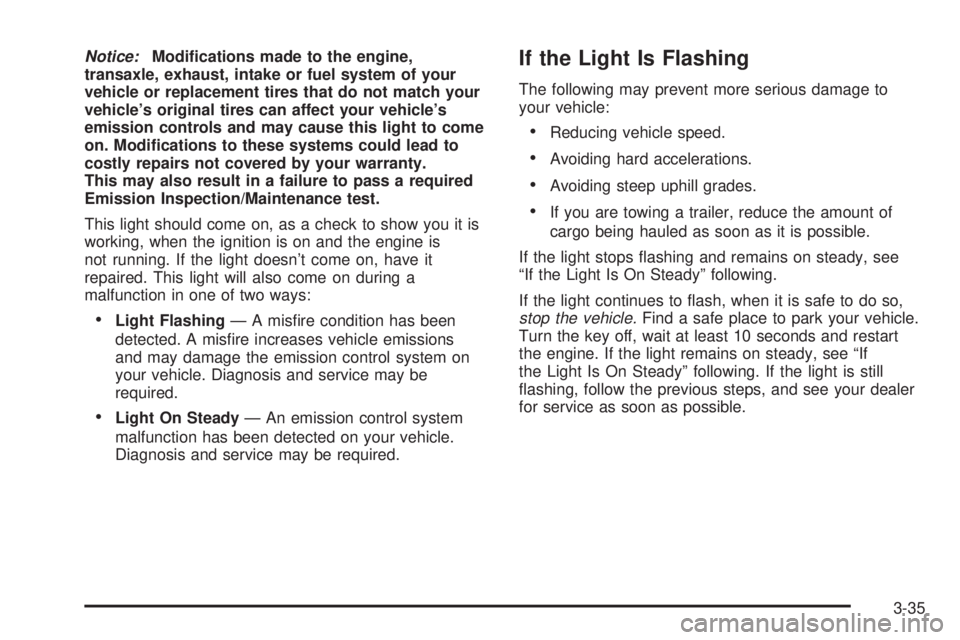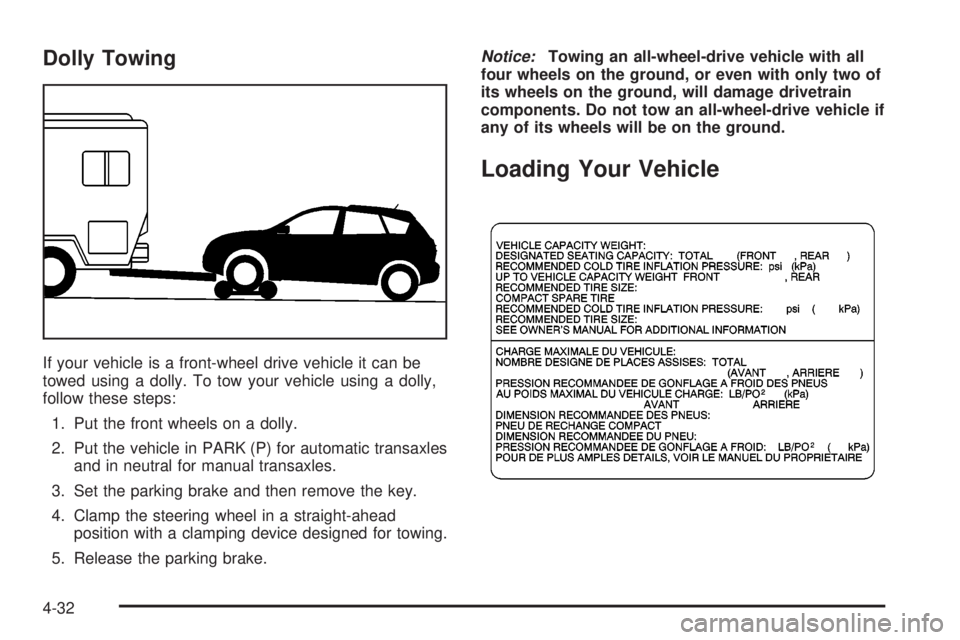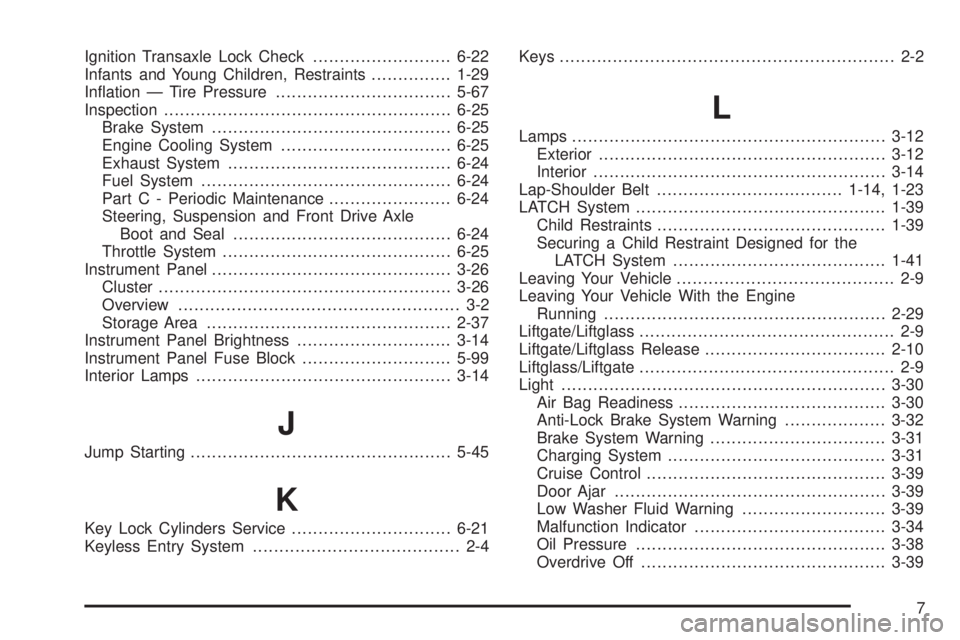key PONTIAC VIBE 2004 Owner's Guide
[x] Cancel search | Manufacturer: PONTIAC, Model Year: 2004, Model line: VIBE, Model: PONTIAC VIBE 2004Pages: 370, PDF Size: 2.68 MB
Page 139 of 370

If the light stays on, turn the ignition to LOCK. Or, if the
light comes on when you're driving, stop as soon as
possible and turn the ignition off. Then start the engine
again to reset the system. If the light still stays on,
or comes on again while you're driving, your vehicle
needs service. If the regular brake system warning light
isn't on, you still have brakes, but you don't have
anti-lock brakes. If the regular brake system warning
light is also on, you don't have anti-lock brakes
and there's a problem with your regular brakes. See
Brake System Warning Light on page 3-31.
The anti-lock brake system warning light will come on
brie¯y when you turn the ignition key to ON. This is
normal. If the light doesn't come on then, have it ®xed
so it will be ready to warn you if there is a problem.
Engine Coolant Temperature Gage
This gage shows the engine coolant temperature. If the
gage pointer moves into the red area, your engine is
too hot! It means that your engine has overheated. If you
have been operating your vehicle under normal driving
conditions, you should pull off the road, stop your
vehicle and turn off the engine as soon as possible. See
Engine Overheating on page 5-30. United States
Canada
3-33
Page 141 of 370

Notice:Modi®cations made to the engine,
transaxle, exhaust, intake or fuel system of your
vehicle or replacement tires that do not match your
vehicle's original tires can affect your vehicle's
emission controls and may cause this light to come
on. Modi®cations to these systems could lead to
costly repairs not covered by your warranty.
This may also result in a failure to pass a required
Emission Inspection/Maintenance test.
This light should come on, as a check to show you it is
working, when the ignition is on and the engine is
not running. If the light doesn't come on, have it
repaired. This light will also come on during a
malfunction in one of two ways:
·Light FlashingÐ A mis®re condition has been
detected. A mis®re increases vehicle emissions
and may damage the emission control system on
your vehicle. Diagnosis and service may be
required.
·Light On SteadyÐ An emission control system
malfunction has been detected on your vehicle.
Diagnosis and service may be required.
If the Light Is Flashing
The following may prevent more serious damage to
your vehicle:
·Reducing vehicle speed.
·Avoiding hard accelerations.
·Avoiding steep uphill grades.
·If you are towing a trailer, reduce the amount of
cargo being hauled as soon as it is possible.
If the light stops ¯ashing and remains on steady, see
ªIf the Light Is On Steadyº following.
If the light continues to ¯ash, when it is safe to do so,
stop the vehicle.Find a safe place to park your vehicle.
Turn the key off, wait at least 10 seconds and restart
the engine. If the light remains on steady, see ªIf
the Light Is On Steadyº following. If the light is still
¯ashing, follow the previous steps, and see your dealer
for service as soon as possible.
3-35
Page 173 of 370

Many adults Ð by some estimates, nearly half the adult
population Ð choose never to drink alcohol, so they
never drive after drinking. For persons under 21,
it is against the law in every U.S. state to drink alcohol.
There are good medical, psychological and
developmental reasons for these laws.
The obvious way to eliminate the leading highway
safety problem is for people never to drink alcohol and
then drive. But what if people do? How much is ªtoo
muchº if someone plans to drive? It is a lot less
than many might think. Although it depends on each
person and situation, here is some general information
on the problem.
The Blood Alcohol Concentration (BAC) of someone
who is drinking depends upon four things:
·The amount of alcohol consumed
·The drinker's body weight
·The amount of food that is consumed before and
during drinking
·The length of time it has taken the drinker to
consume the alcohol.
According to the American Medical Association, a 180 lb
(82 kg) person who drinks three 12 ounce (355 ml)
bottles of beer in an hour will end up with a BAC
of about 0.06 percent. The person would reach thesame BAC by drinking three 4 ounce (120 ml) glasses
of wine or three mixed drinks if each had 1-1/2 ounces
(45 ml) of liquors like whiskey, gin or vodka.
It is the amount of alcohol that counts. For example, if
the same person drank three double martinis (3 ounces
or 90 ml of liquor each) within an hour, the person's
BAC would be close to 0.12 percent. A person
who consumes food just before or during drinking will
have a somewhat lower BAC level.
4-3
Page 202 of 370

Dolly Towing
If your vehicle is a front-wheel drive vehicle it can be
towed using a dolly. To tow your vehicle using a dolly,
follow these steps:
1. Put the front wheels on a dolly.
2. Put the vehicle in PARK (P) for automatic transaxles
and in neutral for manual transaxles.
3. Set the parking brake and then remove the key.
4. Clamp the steering wheel in a straight-ahead
position with a clamping device designed for towing.
5. Release the parking brake.
Notice:Towing an all-wheel-drive vehicle with all
four wheels on the ground, or even with only two of
its wheels on the ground, will damage drivetrain
components. Do not tow an all-wheel-drive vehicle if
any of its wheels will be on the ground.
Loading Your Vehicle
4-32
Page 310 of 370

Engine Compartment Fuse Block
This engine compartment fuse block is located in the
engine compartment on the driver's side of the vehicle
near the air cleaner. See
Engine Compartment
Overview on page 5-12for more information on location.
Fuses Usage
HEAD MAINRight Headlamp, Left Headlamp
Fuses
ALT-S Charging System
EFI Electronic Fuel Injection System
HAZARDTurn Signal Lamps, Emergency
Flasher
HORN Horn
DOMEInterior Lights, Gauges and Meters,
Audio System, Remote Keyless
Entry System
Fuses Usage
MAIN Starter System, AM2 Fuse
AMP Audio Ampli®ers
MAYDAY Not Used
SPARE Spare Fuse
SPARE Spare Fuse
SPARE Spare Fuse
ABS NO. 2 Anti-lock Brake System
RDI FAN Electronic Cooling Fan System
ABS NO. 1 Anti-lock Brake System
ALTCharging System, DEFOG,
HEATER, GAUGE, ECU-IG,
WIPER, RR WIP, WASHER, ABS
NO. 1, ABS NO. 2, RDI FAN, FOG,
GAUGE, INV, AM1 Fuses
HEAD RH Right-hand Headlamp
HEAD LH Left-hand Headlamp
FOG Front Fog Lamps
Relays Usage
DIMMER Headlamp Dimmer
FAN NO. 2 Cooling Fan System
FAN NO. 1 Cooling Fan System
EFI Electronic Fuel Injection System
5-100
Page 335 of 370

At Least Once a Year
Key Lock Cylinders Service
Lubricate the key lock cylinders with the lubricant
speci®ed in Part D.
Seat Operation Check
Make sure the head restraints stay in position and all
seat latches lock. Check that the recliner holds by
pushing and pulling the seatback while it is reclined.
Body Lubrication Service
Lubricate all hood latch assembly, secondary latch,
pivots, spring anchor, release pawl, hood and body door
hinges, rear compartment and any folding seat
hardware. Part D tells you what to use. More frequent
lubrication may be required when exposed to a corrosive
environment.
Starter Switch Check
{CAUTION:
When you are doing this check, the vehicle
could move suddenly. If it does, you or others
could be injured. Follow the steps below.
1. Before you start, be sure you have enough room
around the vehicle.
2. Firmly apply both the parking brake and the regular
brake. See
Parking Brake on page 2-27if
necessary.
Do not use the accelerator pedal, and be ready to
turn off the engine immediately if it starts.
3. On automatic transaxle vehicles, try to start the
engine in each gear. The starter should work only in
PARK (P) or NEUTRAL (N). If the starter works in
any other position, your vehicle needs service.
On manual transaxle vehicles, put the shift lever in
NEUTRAL (N), push the clutch down halfway and try
to start the engine. The starter should work only
when the clutch is pushed down all the way to the
¯oor. If the starter works when the clutch isn't pushed
all the way down, your vehicle needs service.
6-21
Page 336 of 370

Automatic Transaxle Shift Lock Control
System Check
{CAUTION:
When you are doing this check, the vehicle
could move suddenly. If it does, you or others
could be injured. Follow the steps below.
1. Before you start, be sure you have enough room
around the vehicle. It should be parked on a level
surface.
2. Firmly apply the parking brake. See
Parking Brake
on page 2-27if necessary.
Be ready to apply the regular brake immediately if
the vehicle begins to move.
3. With the engine off, turn the key to the ON position,
but don't start the engine. Without applying the
regular brake, try to move the shift lever out
of PARK (P) with normal effort. If the shift lever
moves out of PARK (P), your vehicle needs service.
Ignition Transaxle Lock Check
While parked, and with the parking brake set, try to turn
the ignition key to LOCK in each shift lever position.
·With an automatic transaxle, the key should turn to
LOCK only when the shift lever is in PARK (P).
·With a manual transaxle, the key should turn to
LOCK only if you push the key in farther, while
turning it toward LOCK.
6-22
Page 340 of 370

Part D: Recommended Fluids and
Lubricants
Fluids and lubricants identi®ed below by name, part
number or speci®cation may be obtained from your
dealer.
Usage Fluid/Lubricant
Engine OilEngine oil which meets GM
Standard GM6094M and displays
the American Petroleum Institute
Certi®ed for Gasoline Engines
starburst symbol. To determine the
proper viscosity for your vehicle's
engine, see
Engine Oil on
page 5-16.
Engine Coolant50/50 mixture of clean, drinkable
water (preferably distilled) and good
quality Ethylene Glycol Base
Coolant (GM Part No. U.S.
12378560, in Canada 993089,
or equivalent) conforming to GM
Speci®cation 1825M or approved
recycled coolant conforming to GM
Speci®cation 1825M. See
Engine
Coolant on page 5-27.
Usage Fluid/Lubricant
Hydraulic Brake
SystemDelco Supreme 11 Brake Fluid or
equivalent DOT-3 brake ¯uid.
Hydraulic
Clutch SystemSee ªHydraulic Brake System.º
Windshield
Washer SolventGM Optikleen
žWasher Solvent.
Power Steering
SystemDEXRON
ž-III Automatic
Transmission Fluid.
Manual
TransaxleGM Goodwrench Synthetic Manual
Transmission Fluid (GM Part No.
U.S. 12346190, in Canada
10953477 Ð 1 quart) or SAE
75W-90 GL-5 gear oil.
Automatic
TransaxleUse only T-IV Automatic
Transmission Fluid (GM Part No.
U.S. 88900925, in Canada
22689186). See
Automatic
Transaxle Fluid on page 5-23.
Key Lock
CylindersMulti-Purpose Lubricant, Superlube
(GM Part No. U.S. 12346241, in
Canada 10953474).
6-26
Page 363 of 370

Ignition Transaxle Lock Check..........................6-22
Infants and Young Children, Restraints...............1-29
In¯ation Ð Tire Pressure.................................5-67
Inspection......................................................6-25
Brake System.............................................6-25
Engine Cooling System................................6-25
Exhaust System..........................................6-24
Fuel System...............................................6-24
Part C - Periodic Maintenance.......................6-24
Steering, Suspension and Front Drive Axle
Boot and Seal.........................................6-24
Throttle System...........................................6-25
Instrument Panel.............................................3-26
Cluster.......................................................3-26
Overview..................................................... 3-2
Storage Area..............................................2-37
Instrument Panel Brightness.............................3-14
Instrument Panel Fuse Block............................5-99
Interior Lamps................................................3-14
J
Jump Starting.................................................5-45
K
Key Lock Cylinders Service..............................6-21
Keyless Entry System....................................... 2-4Keys............................................................... 2-2
L
Lamps...........................................................3-12
Exterior......................................................3-12
Interior.......................................................3-14
Lap-Shoulder Belt...................................1-14, 1-23
LATCH System...............................................1-39
Child Restraints...........................................1-39
Securing a Child Restraint Designed for the
LATCH System........................................1-41
Leaving Your Vehicle......................................... 2-9
Leaving Your Vehicle With the Engine
Running.....................................................2-29
Liftgate/Liftglass................................................ 2-9
Liftgate/Liftglass Release..................................2-10
Liftglass/Liftgate................................................ 2-9
Light.............................................................3-30
Air Bag Readiness.......................................3-30
Anti-Lock Brake System Warning...................3-32
Brake System Warning.................................3-31
Charging System.........................................3-31
Cruise Control.............................................3-39
Door Ajar...................................................3-39
Low Washer Fluid Warning...........................3-39
Malfunction Indicator....................................3-34
Oil Pressure...............................................3-38
Overdrive Off..............................................3-39
7
Page 366 of 370

Power...........................................................3-17
Accessory Outlets........................................3-17
Door Locks.................................................. 2-8
Electrical System.........................................5-98
Outlet 115 Volt Alternating Current.................3-18
Steering Fluid.............................................5-38
Windows....................................................2-12
Pretensioners, Safety Belt................................1-26
Q
Questions and Answers About Safety Belts.........1-13
R
Radiator Pressure Cap....................................5-29
Radio Data System (RDS).......................3-42, 3-55
Radio Messages.............................................3-47
Radios..........................................................3-41
Care of Your CD Player...............................3-64
Care of Your CDs........................................3-64
Navigation/Radio System..............................3-63
Radio with CD............................................3-42
Radio with Six-Disc CD................................3-52
Setting the Time..........................................3-41
Understanding Reception..............................3-63
RDS Messages......................................3-46, 3-56Reactivating the System..................................2-15
Reading Lamp................................................3-16
Rear Cargo Accessory Track System.................2-40
Rear Combination Lamps.................................5-56
Rear Seat Operation......................................... 1-7
Rear Seat Passenger Positions.........................1-22
Rear Seat Passengers, Safety Belts..................1-22
Rear Storage Area..........................................2-40
Rear Window Defogger....................................3-21
Rearview Mirrors.............................................2-35
Reclining Seatbacks.......................................... 1-3
Recreational Vehicle Towing.............................4-30
Remote Keyless Entry System............................ 2-4
Remote Keyless Entry System, Operation............ 2-5
Removing the Flat Tire and Installing the
Spare Tire..................................................5-80
Removing the Spare Tire and Tools...................5-78
Replacement Bulbs.........................................5-59
Replacing Brake System Parts..........................5-44
Replacing Restraint System Parts After
a Crash.....................................................1-57
Reporting Safety Defects.................................7-10
Canadian Government..................................7-10
General Motors...........................................7-11
United States Government............................7-10
Restraint System Check...................................6-20
Checking Your Restraint Systems...................1-56
Replacing Restraint System Parts After
a Crash..................................................1-57
10